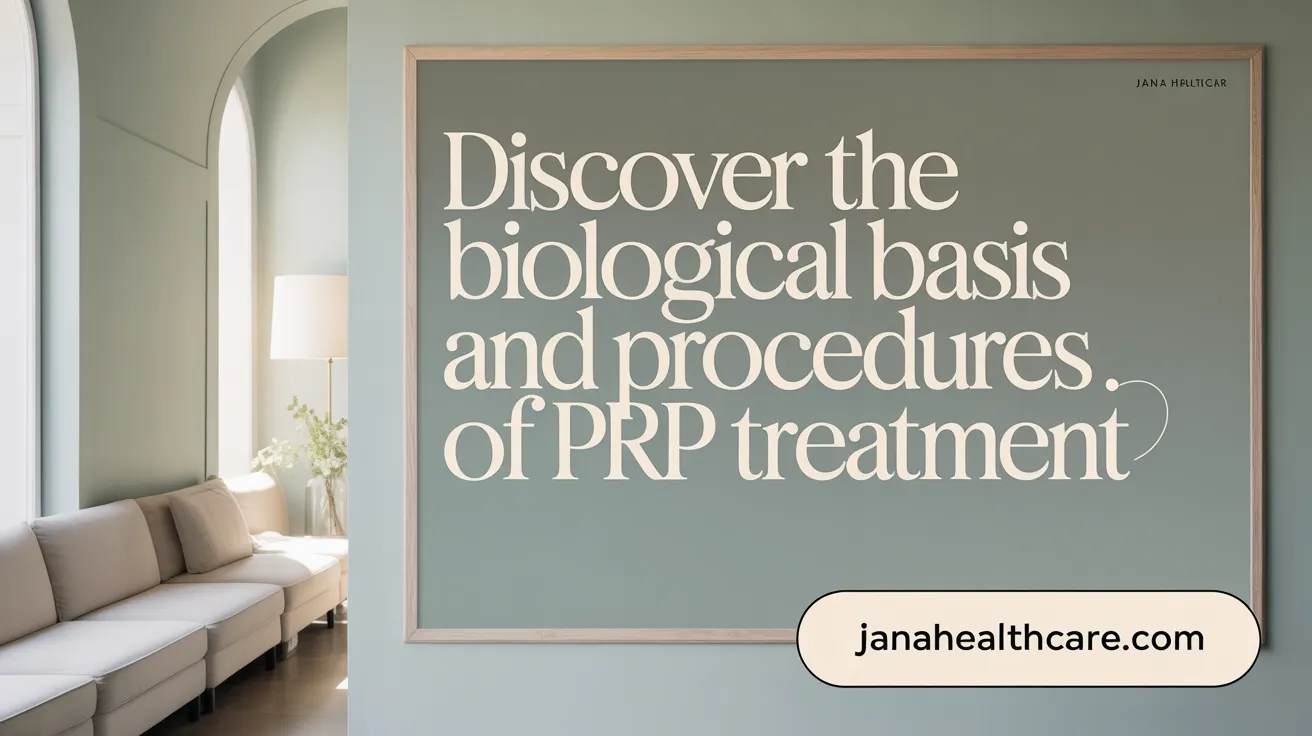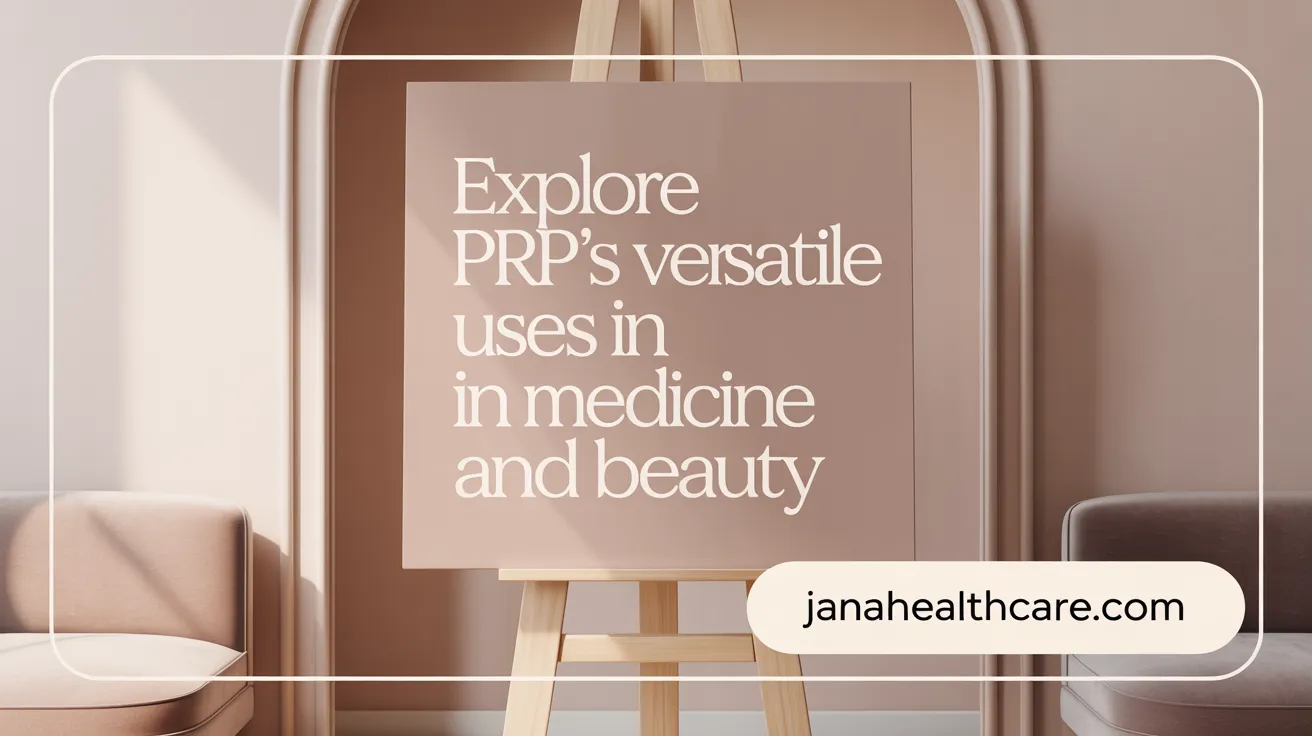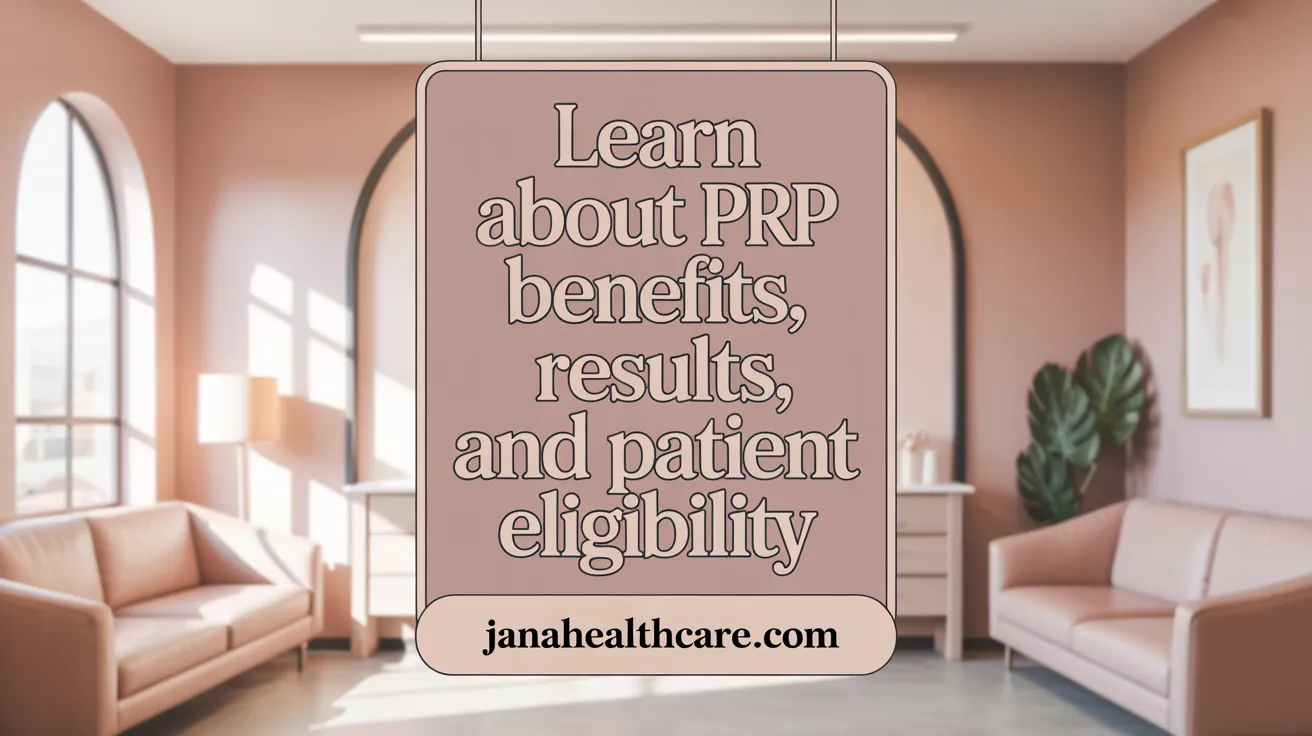Introduction to PRP Therapy
Platelet-rich plasma (PRP) therapy has emerged as a groundbreaking approach in both medical and aesthetic fields. Derived from a patient's own blood, PRP harnesses the body's natural healing properties through concentrated platelets rich in growth factors. This versatile treatment is gaining widespread attention for its potential to accelerate tissue repair, improve skin appearance, and promote hair growth. In this article, we explore everything you need to know about PRP therapy — from its biological basis to procedural details, benefits, risks, scientific evidence, and patient suitability.
The Science Behind PRP and How Treatments Are Administered

What is platelet-rich plasma (PRP) and what is its biological basis in medical and aesthetic treatments?
Platelet-rich plasma (PRP) is an autologous biological product obtained by centrifuging a patient’s blood to concentrate platelets above baseline levels. It contains a rich array of growth factors—such as VEGF, PDGF, FGF, EGF, HGF, and IGF—that promote tissue healing, regeneration, and angiogenesis. The biological basis of PRP’s effectiveness lies in its ability to stimulate cellular proliferation, increase collagen production, enhance blood supply, and modulate inflammation, thereby accelerating tissue repair. In medical and aesthetic treatments, PRP is used for wound healing, skin rejuvenation, scar revision, and hair regrowth, leveraging its capacity to activate fibroblasts and promote follicle stimulation. Its diverse biological effects make PRP a versatile tool in regenerative medicine, with ongoing research aiming to optimize its preparation and application.
How are PRP treatments performed, including the procedural steps and preparation?
PRP treatments commence with drawing a small amount of blood from the patient. This blood is then processed through a double centrifugation protocol to concentrate the platelets to approximately 1 million per milliliter. During centrifugation, parameters such as speed, duration, and temperature are carefully adjusted to maximize platelet yield, with the plasma containing the concentrated platelets isolated afterward. The treatment site is sterilized to prevent infection, and local or topical anesthesia may be applied for patient comfort. The prepared PRP is then injected into the targeted tissue, often guided by ultrasound to ensure precise placement. After the injection, patients might experience mild soreness or swelling, but these effects are temporary. The entire process from blood draw to injection typically takes between 30 to 60 minutes, making it a minimally invasive and efficient procedure.
Diverse Applications of PRP in Medicine and Aesthetic Procedures
 PRP (Platelet-Rich Plasma (PRP) injections) has a broad spectrum of applications across both medical and cosmetic fields, owing to its ability to stimulate tissue regeneration through growth factors. One of its most common uses is in skin rejuvenation, where PRP improves skin texture, tone, and elasticity, and helps diminish wrinkles, fine lines, acne scars, and signs of aging around the eyes and mouth. When combined with microneedling or laser treatments, PRP can enhance collagen production, accelerating skin healing and delivering a more youthful appearance.
PRP (Platelet-Rich Plasma (PRP) injections) has a broad spectrum of applications across both medical and cosmetic fields, owing to its ability to stimulate tissue regeneration through growth factors. One of its most common uses is in skin rejuvenation, where PRP improves skin texture, tone, and elasticity, and helps diminish wrinkles, fine lines, acne scars, and signs of aging around the eyes and mouth. When combined with microneedling or laser treatments, PRP can enhance collagen production, accelerating skin healing and delivering a more youthful appearance.
In hair restoration, PRP is injected into the scalp to stimulate hair follicle growth, proving effective for conditions like male pattern baldness and supporting outcomes after hair transplants. Patients often undergo multiple sessions, with results developing over several months, resulting in thicker, healthier hair and reduced shedding.
Orthopedic injuries constitute another significant application. PRP is used to treat tendinopathies, ligament, and muscle injuries, facilitating faster healing and pain reduction. It’s commonly applied in chronic conditions such as tennis elbow, jumper's knee, rotator cuff tears, and osteoarthritis, where it promotes repair, reduces inflammation, and can prolong joint health (source).
Beyond musculoskeletal healing, PRP plays a role in gynecological and reconstructive medicine. It aids in wound healing, tissue regeneration, and postoperative recovery in procedures like vulvar and cervical surgeries. PRP is also investigated for ovarian rejuvenation, endometrial thickening, and vaginal rejuvenation, showing promising preliminary results in tissue regeneration and functional improvements (source).
Many treatments involve combining PRP with other therapies, such as fat grafting, hyaluronic acid fillers, or laser therapy, to optimize results. These multimodal approaches can lead to enhanced skin quality, improved recovery times, and long-lasting outcomes (source).
In summary, PRP’s regenerative properties make it a versatile tool, applicable in treating a variety of conditions from cosmetic skin aging and hair loss to complex orthopedic injuries and gynecological repairs, with ongoing research continually expanding its uses (source).
Benefits, Expected Outcomes, and Patient Suitability for PRP Therapy

What are the benefits of PRP therapy in terms of healing, skin improvement, and tissue regeneration?
PRP therapy offers several advantages for healing, skin enhancement, and tissue regeneration by harnessing the body's natural growth factors. Derived from a patient's own blood, the concentrated platelets release proteins that promote cellular repair, accelerate tissue healing, and reduce inflammation. Patients often experience faster recovery from musculoskeletal injuries such as tendon, ligament, or muscle damage, with improvements in pain and mobility. In aesthetic applications, PRP stimulates collagen production, improving skin elasticity, texture, and tone, which can lead to a more youthful appearance. Its autologous nature minimizes allergy risks, making it a safe, minimally invasive option to foster natural healing and regeneration, supported by increasing clinical evidence.
What results and outcomes can patients typically expect from PRP therapy?
Patients undergoing PRP treatment generally observe gradual improvements over several weeks to months. For joint and tendon injuries, benefits include pain reduction, increased range of motion, and strengthened tissue structures. Cosmetic outcomes, such as skin tightening and hair growth, typically become visible after multiple sessions, with skin showing enhanced smoothness and density improvements over time. The healing process involves stages of initial inflammation, tissue proliferation, and remodeling, resulting in long-lasting improvements. While individual results vary based on the condition and treatment specifics, most patients report significant symptom relief and tissue repair with minimal side effects, making PRP a promising therapeutic option (PRP treatment timeline and outcomes).
Who is a suitable candidate for PRP treatments and what patient considerations should be taken into account?
Ideal candidates for PRP therapy are those with persistent musculoskeletal issues like tendinitis, ligament injuries, or early to moderate osteoarthritis who have not responded to standard conservative treatments. Good candidates are generally healthy individuals without active infections, blood clotting disorders, or immune suppression, as these conditions can increase risk. Patients should undergo comprehensive evaluation to rule out contraindications such as anticoagulant use, severe joint degeneration, or infections. Younger patients with early signs of tissue degradation may experience better outcomes, although severe cases might be less suitable. It is crucial to consider the patient’s overall health status, treatment expectations, and specific condition to ensure safety and optimize benefits (Patient selection and safety considerations).
For further details on patient selection and benefits, a search for "Benefits and patient selection criteria for PRP therapy" is recommended, focusing on current clinical guidelines and research findings.
Evaluating the Safety Profile and Potential Risks of PRP Treatments
 PRP (platelet-rich plasma) treatments are generally safe because they utilize the patient’s own blood, significantly reducing the risk of allergic or rejection reactions (Platelet-Rich Plasma (PRP) injections, PRP therapy safety). Since the procedure involves autologous blood, the immune system is less likely to respond negatively (Platelet-Rich Plasma Injection Procedure). However, there are still potential risks and side effects to consider (PRP injection side effects, PRP injection risks and safety).
PRP (platelet-rich plasma) treatments are generally safe because they utilize the patient’s own blood, significantly reducing the risk of allergic or rejection reactions (Platelet-Rich Plasma (PRP) injections, PRP therapy safety). Since the procedure involves autologous blood, the immune system is less likely to respond negatively (Platelet-Rich Plasma Injection Procedure). However, there are still potential risks and side effects to consider (PRP injection side effects, PRP injection risks and safety).
Common side effects include temporary discomfort, soreness, swelling, and bruising at the injection site. These symptoms usually resolve within a few days to a week (PRP treatment side effects, Minimal side effects of PRP injections). More rare but serious risks involve infection, nerve injury, and tissue damage, which can occur if strict sterile techniques are not followed during blood collection, processing, or injection (Adverse events of PRP therapy, PRP preparation and contamination risks).
Infection is a primary concern, especially if microbial contamination occurs during the procedure. This risk underscores the importance of using sterile equipment and environment (Infections following PRP injections, Preventing infection in PRP). Nerve injuries, though infrequent, can happen if the injection is not precisely administered, particularly around sensitive areas of the face or joints (Nerve injuries from PRP).
Practitioner expertise and adherence to proper sterile protocols are crucial in minimizing these risks (PRP injection procedure, PRP injection technique and safety). Patients should ensure their healthcare provider is well-trained and follows rigorous sterilization procedures to ensure safety (Who Should Consider PRP Injections).
To reduce the likelihood of adverse outcomes, patients are advised to follow pre- and post-treatment guidelines provided by their medical professional. This may include stopping certain medications like blood thinners beforehand and avoiding anti-inflammatory drugs that could impair healing (Stopping medications before PRP, Pre-treatment guidelines for PRP therapy). Overall, the low complication rate associated with PRP makes it a favorable option, but awareness and proper technique are vital for safe and effective treatment (Safety of PRP injections, Risks of PRP therapy).
Scientific Evidence, Standards, and Evolving Protocols for PRP Therapy
Current scientific research indicates that PRP (platelet-rich plasma) demonstrates promising potential across a range of treatments, especially within orthopedics and regenerative medicine. Numerous randomized controlled trials support its efficacy in conditions such as osteoarthritis, tendinopathies, and ligament injuries, with meta-analyses confirming significant pain relief and functional improvements—most notably in knee osteoarthritis, where effects can last several months to years. In dermatology and aesthetics, studies suggest PRP can enhance skin quality, promote hair growth, and accelerate wound healing, although individual results vary depending on preparation and application methods.
However, the evidence base remains heterogeneous, primarily due to marked variability in preparation protocols across studies. The lack of standardization in centrifugation parameters, platelet concentrations, activation methods, and injection techniques hampers the ability to uniformly replicate and compare outcomes. To address this, research currently aims to identify the optimal platelet concentration—generally around 1 million per mL—and standardize processing methods. Such efforts seek to enhance treatment consistency, safety, and efficacy (source).
Overall, while the safety profile of PRP is favorable, with mostly mild and transient adverse effects, its clinical application continues to evolve. The development of consensus guidelines and standardized protocols is imperative to fully harness PRP’s regenerative capacity. Ongoing research endeavors are crucial for establishing clear, evidence-based practices, ensuring that PRP therapy can be reliably integrated into mainstream medicine and aesthetics.
Conclusion: Harnessing PRP's Potential with Informed Choices
Platelet-rich plasma therapy represents a versatile, natural approach to enhancing healing and aesthetic outcomes using the body’s own regenerative capabilities. With applications ranging from orthopedic injury treatment to skin rejuvenation and hair restoration, PRP offers promising benefits by promoting cellular repair, collagen production, and inflammation modulation. While generally safe and minimally invasive, informed patient selection, skilled procedural administration, and adherence to best practices are essential to minimize risks and optimize results. As scientific research progresses toward standardized protocols and clearer efficacy data, PRP continues to hold significant potential as a valuable tool in both medical and cosmetic treatments, empowering patients and clinicians alike with innovative regenerative solutions.
